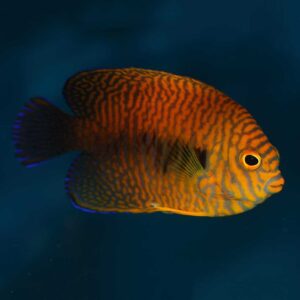Tuka Anthias, Pseudanthias tuka, also go by the name Yellow Stripe Fairy Basslet. Male and female Tuka Anthias look vastly different from one another. Males have amazingly bright pink/purplish bodies and torpedo-like bodies. They have pointed snouts and yellow faces that distinguishes them from similar looking Anthias. Female Tuka Anthias are hot pink in colour. They sport a narrow yellow stripe which runs from their head to tail. Their caudal fins are yellow as opposed to blue.
Tuka Anthias, Pseudanthias tuka, Ecology.
These fish range from: Japan, Australia, Mauritius and the Solomon Islands, in the Indo-West Pacific Ocean. They live on and around: coral reefs, steep slopes, channels, drop offs or caves. The complex structures help the fish dodge predators. When feeling threatened, they will quickly vanish and anchor themselves into nooks and crannies.
In nature, Tuka Anthias feed passively, as do most types of Anthias. Which means they stay in relatively still positions, while facing the current. When Pelagic zooplankton drifts towards them in the water, the fish snatch their food up. With this method, the hunters easily get hold of small critters and eggs, while using up the smallest amount of energy possible. Feeding is fairly constant, although other behaviours punctuate this activity.
These are fish that live in social groups, with one male to around 5 or more females. Tuka Anthias are also protogynous hermaphrodites. Which means when the top male dies, the largest female in the group will turn male. It will then become the new breeding male. As a result, all juvenile Tuka Anthias, are in fact immature females.
Yellow Stripe Fairy Basslet In the Aquarium.
It is important to have good currents and regular feeding in order to imitate the natural environment. A wave maker can help with this. Hobbyists should think about using a jump guard to stop any unfortunate mishaps.
Tuka Anthias do best when fed a varied diet. They will accept frozen mysis shrimp and enriched frozen brine shrimp. They will also eat live foods, such as copepods and amphipods, that can be cultivated in attached refugium. Over time, these fish may have small amounts of high quality flake food as well. Our Anthias are adapted to aquarium life and most are eating a good quality frozen food, enriched with garlic guard and vitamins, before being offered for sale. We find that the best way to keep this species is in a small group. Hobbyists should aim to keep at least 1 Male Tuka Anthias with 3 or more females.





Reviews
There are no reviews yet.